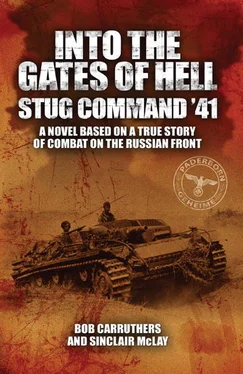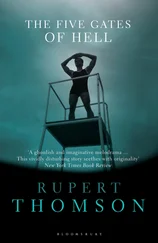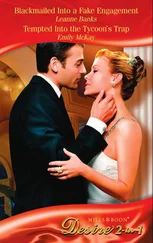“Never, SS-Sturmbannführer,’ replied the Wehrmacht officer.
“Good man! Assault guns are only to be used in towns and woods in exceptional circumstances only, and only in conjunction with particularly strong and close infantry support. Remember, assault guns are not suitable for use in darkness, so at least you should get some sleep!”
Voss allowed a moment’s pause to let the small ripple of laughter die down before continuing.
“It is the special role of the assault-gun battery to assist the infantry in fighting its way through deep enemy defence zones. Therefore, it must not be committed until the divisional artillery and the heavy infantry weapons can no longer render adequate support. When in action the battery commander, together with his platoon commanders, must at all times be familiar with the hostile situation, and must reconnoitre the ground over which he is to move and attack.”
Voss was now on the home straight and he paused briefly to allow the information to sink in.
“I see faces here that I know from Spain and Poland. I’m sure you’ll agree that it looks superior to the Panzer I we had out there, eh, von Schroif?”
Von Schroif nodded his assent and Voss continued.
“And we still shook up the Reds, even with that. The proof of the tapas is in the eating gentlemen. One day soon I think you’ll get a chance to compare the two. I think you’ll find our new friend, the StuG, up to the task.”
* * * * *
The promised day had arrived very soon indeed. By May 1940 von Schroif and his crew were rolling into action for the first time. As he stood in the stillness of a Polish pine forest on the eve of Barbarossa, von Schroif could hardly credit the fact that it was just over a year since the day when they had first moved into combat in the Sturmgeschütz. It seemed simultaneously like yesterday and a life time ago.
During the long pause in which von Schroif had been lost in thought, SS-Kannonier Wohl had stood perfectly still, patiently awaiting the next word from von Schroif, but his commander’s thoughts were far away from eastern Poland. In his mind’s eye von Schroif was 1,000 kilometres away to the west, he was back in the green fields and pleasant towns of rural France. Once again he recalled the tension of that first day in action.
For three agonising hours von Schroif had watched in nervous frustration as the grenadiers advanced methodically toward the village of Narbonne, meeting increasing resistance, and were finally stopped at the eastern edge by strong hostile fire. It was then that the company commander, after considering the situation for what seemed like a lifetime, had at last sent the oral message to the rear: “Sturmgeschütze Vor!” ◦— Assault battery to the front!
The 1st Platoon of the armoured assault artillery battery needed no further invitation and dashed forward to engage in its first fight. To his intense frustration von Schroif, as battery commander, had not been allocated a Sturmgeschütz, but had instead been assigned a command vehicle known as a Beobachtungskraftwagen . It was a tiny and lightly armoured observation halftrack with the official designation of Sd.Kfz. 253. The prevailing logic was that the actions of the assault guns should be directed by this flimsy tin can, but orders were orders, and von Schroif, in his command vehicle, gingerly followed assault guns number 5 and 6 into action.
There followed a nerve-jangling ride past the abandoned houses, every man alert for the crack of an anti-tank weapon. Fortunately, the platoon encountered no resistance until it arrived at the centre of town, when suddenly they heard the rat-a-tat of a heavy machine gun. The machine-gunner was highly accurate and in the cramped interior of the StuG tiny chips of steel detached themselves and flew around the compartment, cutting and tormenting the crewmembers, whose nerves were already strained to breaking point. With the limited vision from inside the vehicle the location of the gun and even the direction of fire was hard to pinpoint and the StuG continued to receive heavy machine-gun fire as it trundled obstinately forward.
Eventually the ever-vigilant von Schroif spotted the source of the bullets that streamed forth like angry wasps from the upper storey of the Town Hall. The machine gun bullets splayed and ricocheted off the strong frontal armour but not a single shot penetrated the hull and, to the mighty relief of the crew, the first test was passed.
From his command half-track von Schroif remained intensely watchful and the exact source of the fire was quickly spotted◦— first floor, two windows along from the main door. SS-Oberkannonier Karl Wendorff relayed von Schroif’s orders over by radio.
“Machine gun nest, 11 o’clock, first floor elevation.”
Inside the StuG a high-explosive shell was rammed into the semi-automatic breach and as quick as lightning the gun was fired by marksman SS-Hauptscharführer Michael Knispel. The death-dealing response was served upon the Frenchmen as two high-explosive rounds from assault gun number 5 crashed into the building, immediately silencing the machine guns. The StuG had drawn its first blood.
Under the expert guidance of von Schroif, assault gun number 6 then went into action. The command came over the radio. “Enemy artillery. 2 o’clock. Range 400 meters.”
The French artillery von Schroif had spotted were sheltering behind the nearby buildings. He watched in satisfaction as one shell exploded in a courtyard among the horses of the gun teams. The uninjured animals galloped away, frightened by the explosion.
Assault gun number 5 then swung into position in the churchyard to silence hostile machine guns which were firing from two windows in a large building. From close by von Schroif, remaining exposed in the commander’s hatch of his half-track, relayed the order to fire on this target and a further two high-explosive rounds from the assault gun served to silence them.
Dismayed by the accurate fire from this effective new weapon the French quickly evacuated the main street and the centre of the town, but machine-gun resistance was renewed at the western edge of the village and the infantry commander requested that the assault guns should be sent ahead again.
The assault guns, now six strong, soon reached a destroyed bridge across a tributary of the Semois River. The pioneers, although hard at work, had not yet completed their task here, but the guns managed to ford the river. The half-track however was unable to follow, and von Schroif took matters into his own hands. He abandoned his Beobachtungskraftwagen and pulled rank to oust the startled commander of assault gun number 5 from his machine, leaving Wendorff to maintain communications.
Slipping down into the poky interior von Schroif immediately entered the claustrophobic world of the fighting vehicle. Every millimetre of space was occupied with controls, levers, dials, projecting metal, ammunition and gear of every description, which left no room for anything more than the lithe frames of the crew. The poorly ventilated sweat-soaked interior was uninviting in the extreme. It was a miniature version of hell and the brimstone in the atmosphere was real; the air was literally thick with smoke and cordite from the shells which had already been fired in it◦— it was hot to breathe and produced a searing on the lungs which made it painful to inhale. Even an old hand like von Schroif needed a few seconds to adjust to his fetid surroundings.
However, for his pains he did receive a welcoming and cheery nod from the gunner, SS-Hauptscharführer Knispel, who was well known to him from their days together in Spain and Poland. He hadn’t chosen this gun by accident. Von Schroif was confident of the fact that, if anyone was going to make this new fighting vehicle a success, it was SS-Hauptscharführer Michael Knispel. Never taking his eyes off the viewing device, von Schroif gave the command “Sturmgeschütze Vor!” and the StuG moved forward purposefully. Von Schroif was now back in his element.
Читать дальше












